Advertisement |
 |
Nature Reviews Chemistry is now live!
Nature Reviews Chemistry provides both an introduction to chemists embarking on a new topic of investigation and thought-provoking, in-depth sections for the expert. The first issue is now published and is free to view online for a limited time.
Read the first issue |  | |
 |
 |
TABLE OF CONTENTS
|
February 2017 Volume 9, Issue 2 |
 |  |  |
 |  Commentary Commentary
 Thesis Thesis
 News and Views News and Views
 Articles Articles
 In Your Element In Your Element | |
 |
|
 |
 |
| Advertisement |
 |
Open for Submissions
A new open access, multi-and interdisciplinary journal dedicated to publishing the finest research on both microbial biofilms and microbiomes, the journal is now open for submissions.
Explore the benefits of submitting your next research article. |  | |
 |
| |
Commentary |  Top Top |
 |
 |
 |
Teaching science through video games pp97 - 102
Ronald A. Smaldone, Christina M. Thompson, Monica Evans and Walter Voit
doi:10.1038/nchem.2694
Imagine a class without lessons, tests and homework, but with missions, quests and teamwork. Video games offer an attractive educational platform because they are designed to be fun and engaging, as opposed to traditional approaches to teaching through lectures and assignments. |
 |
Thesis |  Top Top |
 |
 |
 |
Hedgehogs and foxes (and a bear) pp103 - 104
Bruce Gibb
doi:10.1038/nchem.2726
The chemical universe is big. Really big. You just won't believe how vastly, hugely, mind-bogglingly big it is. Bruce Gibb reminds us that it's somewhat messy too, and so we succeed by recognizing the limits of our knowledge. |
 |
News and Views |  Top Top |
 |
 |
 |
|
 |
| Advertisement |
 |
An open access, online-only, multidisciplinary research journal dedicated to publishing the most important scientific advances in the life sciences, physical sciences, and engineering fields that are facilitated by spaceflight and analogue platforms.
Explore the benefits of submitting your next research article. |  | |
 |
| |
Articles |  Top Top |
 |
 |
 |
Predatory behaviour in synthetic protocell communities pp110 - 119
Yan Qiao, Mei Li, Richard Booth and Stephen Mann
doi:10.1038/nchem.2617
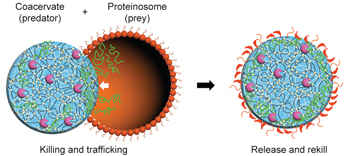
The chemical construction of compartmentalized colloidal objects with biomimetic functions and collective properties is a key challenge in synthetic protocell research. Now, an interacting binary community of protocells has been designed to display artificial predatory behaviour in which protease-containing coacervate microdroplets obliterate a population of proteinosomes, and capture a chemical payload via a simple trafficking process.
See also: News and Views by Mansy |
 |
 |
 |
Adsorbate-mediated strong metal–support interactions in oxide-supported Rh catalysts pp120 - 127
John C. Matsubu, Shuyi Zhang, Leo DeRita, Nebojsa S. Marinkovic, Jingguang G. Chen et al.
doi:10.1038/nchem.2607
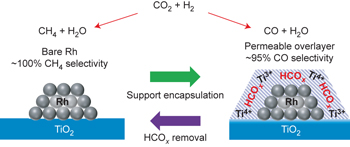
Developing approaches to tune the reactivity and selectivity of supported-metal heterogeneous catalysts is critical for designing environmentally friendly chemical conversion processes. A reversible structural catalyst transformation has now been identified that involves the adsorbate-mediated encapsulation of Rh nanoparticles by their oxide support and enables dynamic tuning of the selectivity of CO2 reduction.
See also: News and Views by Chandler |
 |
 |
 |
Mechanically interlocked daisy-chain-like structures as multidimensional molecular muscles pp128 - 134
Jia-Cheng Chang, Shin-Han Tseng, Chien-Chen Lai, Yi-Hung Liu, Shie-Ming Peng et al.
doi:10.1038/nchem.2608

By exploiting structural rigidity, coordination geometries and bond rotational barriers that disfavour the formation of smaller homologues, molecular switches based on [c3] and [c4]daisy chains have been assembled selectively; they display muscle-like motion in multiple dimensions with changes in length of approximately 23% and 36%, respectively.
Chemical compounds
See also: News and Views by Fournel-Marotte & Coutrot |
 |
 |
 |
Mechanically controlled radical polymerization initiated by ultrasound pp135 - 139
Hemakesh Mohapatra, Maya Kleiman and Aaron Palmer Esser-Kahn
doi:10.1038/nchem.2633

Mechanochemically controlled polymerization is rare in polymer chemistry. Now, it has been shown that mechanical force can initiate and control the polymerization of an acrylate monomer. Piezochemical reduction of a copper(ii) precursor using mechanical agitation of piezoelectric nanoparticles generates the polymerization activator required for controlled radical polymerization.
Chemical compounds |
 |
 |
 |
Enantioselective amine α-functionalization via palladium-catalysed C–H arylation of thioamides pp140 - 144
Pankaj Jain, Pritha Verma, Guoqin Xia and Jin-Quan Yu
doi:10.1038/nchem.2619
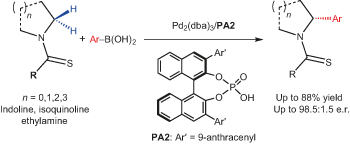
Chiral, saturated N-heterocycles are prized as pharmaceutical agents and chiral auxiliaries, but are challenging to access without using prefunctionalized starting materials. Now, chiral phosphoric acids are found to enable the enantioselective Pd(ii)-catalysed arylation of α-methylene C–H bonds in a wide variety of amines using thioamide as the directing group.
Chemical compounds |
 |
 |
 |
Photoswitching of glass transition temperatures of azobenzene-containing polymers induces reversible solid-to-liquid transitions pp145 - 151
Hongwei Zhou, Changguo Xue, Philipp Weis, Yasuhito Suzuki, Shilin Huang et al.
doi:10.1038/nchem.2625
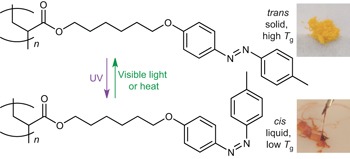
Reversibly inducing solid-to-liquid transitions of polymers at room temperature represents a challenge for enhanced processability and applications of polymers. Now, three azopolymers have been shown to exhibit photoswitchable glass transition temperatures, resulting in reversible solid-to-liquid transitions. Light exposure can heal cracks in hard azopolymers, reduce surface roughness of azopolymer films and control azopolymer adhesion. |
 |
 |
 |
Ballbot-type motion of N-heterocyclic carbenes on gold surfaces pp152 - 156
Gaoqiang Wang, Andreas Rühling, Saeed Amirjalayer, Marek Knor, Johannes Bruno Ernst et al.
doi:10.1038/nchem.2622
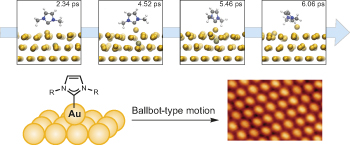
STM investigations and first principles calculations provide an understanding of the microscopic mechanism behind the mobility of N-heterocyclic carbenes (NHCs) on gold surfaces. Now, it is shown that a ballbot-type motion allows the formation of self-assembled monolayers due to the NHC extracting a gold atom from the surface, leading to a ligated gold adatom. |
 |
 |
 |
A synthetic redox biofilm made from metalloprotein–prion domain chimera nanowires pp157 - 163
Lucie Altamura, Christophe Horvath, Saravanan Rengaraj, Anaëlle Rongier, Kamal Elouarzaki et al.
doi:10.1038/nchem.2616
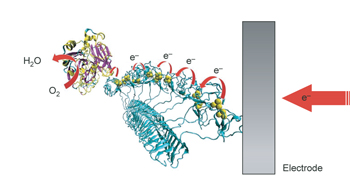
A protein-only redox film inspired by the architecture of bacterial electroactive biofilms has been developed. The film is formed using a rubredoxin–prion domain chimeric protein. The prion domains self-assemble into fibres that are decorated with rubredoxin. This results in highly organized films, able to transport electrons over several microns, and wire enzymes to electrodes. |
 |
 |
 |
Unexpected mechanochemical complexity in the mechanistic scenarios of disulfide bond reduction in alkaline solution pp164 - 170
Przemyslaw Dopieralski, Jordi Ribas–Arino, Padmesh Anjukandi, Martin Krupicka and Dominik Marx
doi:10.1038/nchem.2632
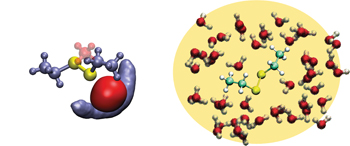
The controlled mechanical activation of specific covalent bonds is a rapidly expanding field in chemistry. Now, it is shown that disulfide bond reduction proceeds through different mechanisms depending on the external force applied. This strongly suggests that refined models should be used when interpreting mechanochemical experiments, particularly when sonication is involved. |
 |
 |
 |
Sequence-controlled methacrylic multiblock copolymers via sulfur-free RAFT emulsion polymerization pp171 - 178
Nikolaos G. Engelis, Athina Anastasaki, Gabit Nurumbetov, Nghia P. Truong, Vasiliki Nikolaou et al.
doi:10.1038/nchem.2634

Achieving sequence control in a synthetic polymer is more challenging and time consuming than it is for biopolymers. Now, it has been shown that the synthesis of sequence-controlled multiblock copolymers can be carried out via emulsion polymerization. This approach is environmentally friendly and yields complex multiblock materials with low dispersity and high yields. |
 |
 |
 |
By-design enantioselective self-amplification based on non-covalent product–catalyst interactions pp179 - 187
Golo Storch and Oliver Trapp
doi:10.1038/nchem.2638
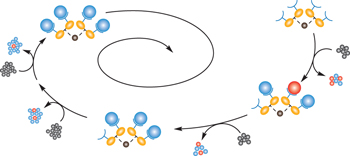
Methods for preparing enantiomerically enriched products are often dependent on the structure of a catalyst. Here, it is shown that a self-amplifying catalyst is able to ‘sense’ the chirality of the catalytic product and induce enantioselectivity. Flexible ligand and product interaction sites are key to the increasing enantioselectivity over the course of the reaction.
Chemical compounds |
 |
 |
 |
Hydrolytic cleavage of both CS2 carbon–sulfur bonds by multinuclear Pd(II) complexes at room temperature pp188 - 193
Xuan-Feng Jiang, Hui Huang, Yun-Feng Chai, Tracy Lynn Lohr, Shu-Yan Yu et al.
doi:10.1038/nchem.2637
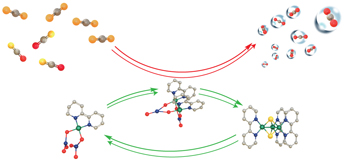
Converting CS2 and COS pollutants into benign products is critical in eliminating waste exhaust fumes. Now, a series of air-stable palladium complexes mediate hydrolysis of both CS2 carbon–sulfur bonds at 25 °C to produce CO2. Oxidation of the resulting complexes regenerates the starting complexes with SO2 and NO2 release.
Chemical compounds |
 |
In Your Element |  Top Top |
 |
 |
 |
The neodymium neologism p194
Brett F. Thornton and Shawn C. Burdette
doi:10.1038/nchem.2722
From grand challenges of nineteenth century chemistry to powerful technology in small packages, Brett F. Thornton and Shawn C. Burdette explain why neodymium is the twin element discovered twice by two Carls. |
 |
 Top Top |
 |
 |
 |  |  |  |  |  | Natureevents is a fully searchable, multi-disciplinary database designed to maximise exposure for events organisers. The contents of the Natureevents Directory are now live. The digital version is available here.
Find the latest scientific conferences, courses, meetings and symposia on natureevents.com. For event advertising opportunities across the Nature Publishing Group portfolio please contact natureevents@nature.com |  |  |  |  |  |
|
 |


No comments:
Post a Comment